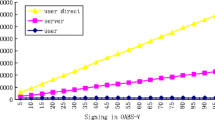Abstract
Emerging attribute based signature (ABS) can be used in the system to protect the individual privacy from being divulged. However, heavy computational cost is required during the signing phase because it grows linearly with the size of attributes. Besides, traditional ABS only supports threshold access structure, which impedes system managers to define more flexible access policy. Aiming at tackling the problems above, we utilize the outsourcing technique with which users can deliver majority of the computation operation to an untrusted cloud server without revealing the private signing key, then propose an expressive outsourced attribute based signature scheme. The proposed scheme is proven unforgeable under selective-attribute chosen message attack in the standard model. Comparing with existing work, our scheme not only reduces users’ computation overhead, but also supports more flexible access structure. Finally, experiments are performed to illustrate the efficiency and practicality of our scheme.




Similar content being viewed by others
References
Lu R, Lin X, Shen X (2013) SPOC: A secure and privacy-preserving opportunistic computing framework for mobile-healthcare emergency. IEEE Trans Parallel Distrib Syst 24(3):614–624
Chib A, van Velthoven M H, Car J. (2015) mHealth adoption in low-resource environments: A review of the use of mobile healthcare in developing countries. J Health Commun 20(1):4–34
Goyal V, Pandey O, Sahai A, Waters B. (2006) Attribute-based encryption for fine-grained access control of encrypted data. In: Proceedings of the 13th ACM conference on computer and communications security (CCS)
Bethencourt J, Sahai A, Waters B. (2007) Ciphertext-policy attribute-based encryption. In: Proceedings of the 28th IEEE symposium on security and privacy (SP)
Maji H K, Prabhakaran M, Rosulek M. (2011) Attribute-based signatures. In: Proceedings of the 11th cryptographers track at the RSA conference (CT-RSA)
Li J, Au M H, Susilo W, Xie D, Ren K. (2010) Attribute-based signature and its applications. In: Proceedings of the 5th ACM Symposium on information, computer and communications security (ASIACCS)
Okamoto T, Takashima K. (2011) Efficient attribute-based signatures for non-monotone predicates in the standard model. In: Proceedings of the 14th international conference on public key cryptography (PKC)
Su J, Cao D, Zhao B, Wang X, You I. (2014) ePASS: An expressive attribute-based signature scheme with privacy and an unforgeability guarantee for the internet of things. Future Gener Comput Syst 33:11–18
Rao Y S, Dutta R. (2016) Efficient attribute-based signature and signcryption realizing expressive access structures. Int J Inf Secur 15(1):81–109
Li J, Chen X, Huang X. (2015) New attributeCbased authentication and its application in anonymous cloud access service. Int J Web Grid Serv 11(1):125–141
Armbrust M, Fox A, Griffith R, Joseph A D, Katz R, Konwinski A, Lee G, Patterson D, Rabkin A, Stoica I, Zaharia M. (2010) A view of cloud computing. Commun the ACM 53(4):50–58
Zhang Q, Cheng L, Boutaba R. (2010) Cloud computing: state-of- the-art and research challenges. J Internet Serv Appl 1(1):7–18
Jakobsson M, Wetzel S (2001) Secure server-aided signature generation. In: Proceedings of the 4th international conference on public key cryptography (PKC)
Chow S S M, Au M H, Susilo W (2013) Server-aided signatures verification secure against collusion attack. Inf Secur Tech Rep 17(3):46–57
Gentry C. (2009) Fully homomorphic encryption using ideal lattices. In: Proceedings of the 41th annual symposium on the theory of computing (STOC
Gennaro R, Gentry C, Parno B. (2010) Non-interactive verifiable computing: Outsourcing computation to untrusted workers. In: Proceedings of the 30th annual cryptology conference (CRYPTO)
Goldwasser S, Kalai Y T, Rothblum G N. (2008) Delegating computation: interactive proofs for muggles. In: Proceedings of the 40th annual ACM symposium on the theory of computing (STOC)
Gentry C, Halevi S. (2011) Implementing Gentrys fully-homomorphic encryption scheme. In: Proceedings of the 30th annual international conference on the theory and applications of cryptographic techniques (EUROCRYPT)
Chen X, Li J, Huang X, Li J, Xiang Y. (2014) Secure outsourced attribute-based signatures. IEEE Trans Parallel Distrib Syst 25(12):3285–3294
Liu Z, Yan H, Li Z. (2015) Server-aided anonymous attribute-based authentication in cloud computing. Future Gener Comput Syst 52:61–66
Li J, Li X, Wang L, He D, Ahmad H, Niu X (2017) Fuzzy encryption in cloud computation: efficient verifiable outsourced attribute-based encryption. Soft Comput, 1–8. https://doi.org/10.1007/s00500-017-2482-1
Li Q, Ma J, Li R, Liu X, Xiong J, Chen D. (2016) Secure, efficient and revocable multi-authority access control system in cloud storage. Comput Secur 59:45–59
Jiang Q, Chen Z, Li B, Shen J, Yang L, Ma J (2017) Security analysis and improvement of bio-hashing based three-factor authentication scheme for telecare medical information systems. J Ambient Intell Humaniz Comput, 1–13. https://doi.org/10.1007/s12652-017-0516-2
Jiang Q, Ma J, Yang C, Ma X, Shen J, Chaudhry S A (2017) Efficient end-to-end authentication protocol for wearable health monitoring systems. Comput Electr Eng 63:182–195. https://doi.org/10.1016/j.compeleceng.2017.03.016
Jiang Q, Zeadally S, Ma J, He D. (2017) Lightweight three-factor authentication and key agreement protocol for internet-integrated wireless sensor networks. IEEE Access 5:3376–3392
Li X, Niu J, Kumari S, Wu F, Choo K K R. (2017) A robust biometrics based three-factor authentication scheme for Global Mobility Networks in smart city. Future Gener Comput Syst, 1–12
Li X, Ibrahim M H, Kumari S, Sangaiah A K, Gupta V, Choo K K R. (2017) Anonymous mutual authentication and key agreement scheme for wearable sensors in wireless body area networks. Comput Netw, 1–15
Acknowledgements
This work was supported by the National High Technology Research and Development Program (863 Program) (No. 2015AA016007, No. 2015AA011704, No. 2015AA017203), the Key Program of NSFC (No. U1405255, No. U1135002), the Shaanxi Science Technology Coordination Innovation Project (No. 2016TZC-G-6-3) and the Fundamental Research Funds for the Central Universities (No. BDZ011402), the National Natural Science Foundation of China (No. 61502248) and the NUPTSF (No. 215008). The authors would like to thank the editors and the anonymous reviewers for their constructive comments that would help us to improve this paper.
Author information
Authors and Affiliations
Corresponding author
Rights and permissions
About this article
Cite this article
Mo, R., Ma, J., Liu, X. et al. EOABS: expressive outsourced attribute-based signature. Peer-to-Peer Netw. Appl. 11, 979–988 (2018). https://doi.org/10.1007/s12083-017-0626-9
Received:
Accepted:
Published:
Issue Date:
DOI: https://doi.org/10.1007/s12083-017-0626-9




